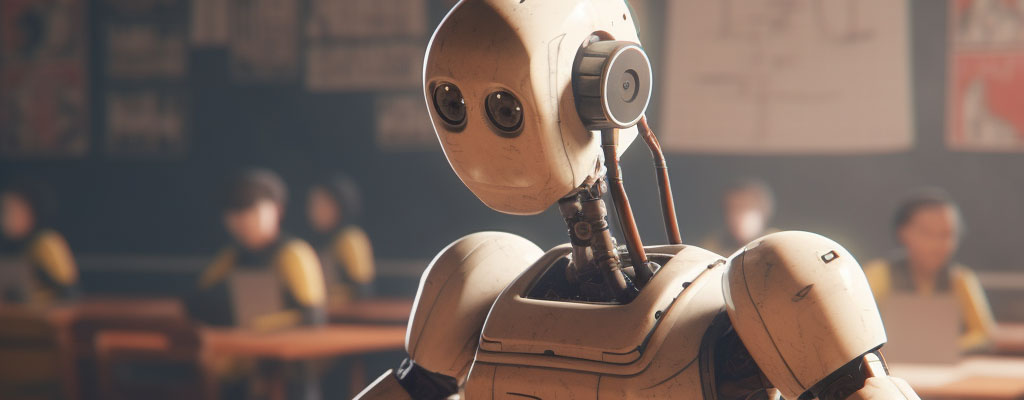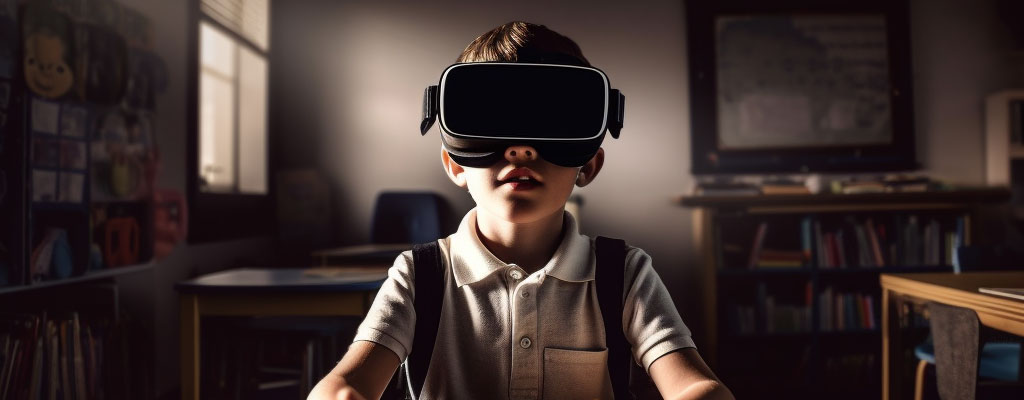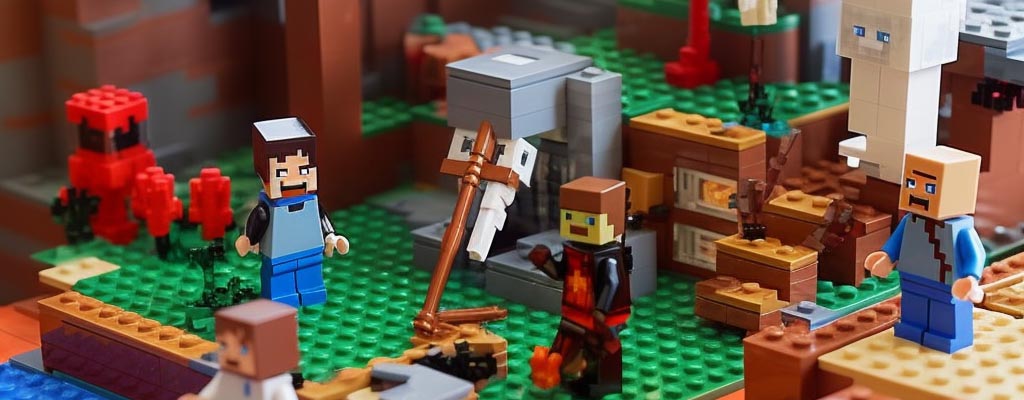5 EdTech Trends of 2023


The wheels of innovation never stop turning, especially in the realm of educational technology - or as it's more commonly known, EdTech.
The potential of digital technology is unlocking innovative methods to revolutionise learning. Emerging and well-established EdTech trends and solutions are harnessing this potential like never before, moulding the future of our learning, teaching, and educational model frameworks.
Technology has proven to be a game-changer in shaping the educational landscape from virtual classrooms to adaptive learning platforms. In this article, we’ll cover 5 of the latest EdTech trends that are revolutionising how we teach, learn, and interact in 2023.

The transformation of teaching and learning processes through digital innovation is no longer a concept of the future, but our present reality. A significant catalyst for this change is Artificial Intelligence (AI). In 2023, the use of AI in education and assessment tools has seen an exponential increase, offering a personalised learning experience that could revolutionise how students learn, and teachers teach.
One of the main ways AI has transformed the educational landscape is through personalisation. AI-driven educational platforms can analyse vast amounts of data to understand a student's learning style, strengths, and weaknesses. These insights are used to create individualised learning paths tailored to each student's needs. This personalisation allows for an adaptable and dynamic learning experience that conventional classroom settings might not always provide.
In 2023, AI educational tools have evolved to become even more sophisticated. They can provide real-time feedback to students, guide them through complex problem-solving tasks, and even adapt the content based on their performance. This adaptive learning can result in increased engagement and improved academic outcomes.
Beyond the realm of learning, AI has also made significant inroads into the world of student assessment. Traditional testing methods often fall short of accurately gauging a student's comprehensive understanding of a subject. This is where AI-powered assessment tools have shown great promise.
In 2023, these AI-driven assessment tools are capable of creating and grading tests, minimising human error and bias. More impressively, they can evaluate students' critical thinking and problem-solving skills by analysing patterns in their responses. This offers a more holistic view of a student's academic abilities, going beyond what standard tests and examinations can provide.
Furthermore, AI-based assessment tools offer real-time data analysis, providing immediate feedback to both students and educators. This instant feedback mechanism allows for timely intervention and adjustment in teaching strategies, further enhancing the learning experience.
Artificial Intelligence in education and assessment is not a passing trend. It's an innovative approach to teaching and learning that's here to stay. This year marks a significant leap in its adoption and sophistication, transforming the educational landscape for the better.

Among the most ground-breaking developments in recent years is the emergence of Extended Reality (XR), Virtual Reality (VR), and Augmented Reality (AR) in educational settings. These immersive technologies offer a completely novel approach to learning, taking students beyond the confines of the traditional classroom and offering them the opportunity to experience learning in a whole new way.
Extended Reality (XR) encompasses both Virtual Reality (VR) and Augmented Reality (AR), combining elements of the real and virtual world to create an immersive learning environment. In the context of education, XR can be used to simulate complex scenarios or concepts that might be difficult to visualize or comprehend through traditional teaching methods.
For example, in a biology class, XR can be used to create a detailed, interactive model of the human body, allowing students to explore various systems and organs in a way that textbooks simply cannot provide. Similarly, history students can be transported back in time to walk through ancient civilizations and witness historical events first-hand. This immersive, interactive approach not only makes learning more engaging but also promotes a deeper understanding of the subject matter.
Virtual Reality (VR) offers a fully immersive digital experience where users can interact with a 3D world using VR headsets. In education, VR can provide students with immersive, hands-on experiences that can significantly enhance their understanding and retention of complex concepts.
For instance, VR can enable students to take a virtual field trip to distant locations, explore outer space, or dive deep into the ocean, all from the safety of their classroom. These experiences can make learning more exciting and memorable, fostering a love of learning in students.
The affordability of standalone VR headsets is improving, with prices predicted to plummet to £200 by the end of 2023, and potentially even lower for mobile-based VR units. This trend towards more cost-effective units is opening the door for a greater number of schools to incorporate VR technology as a regular component of their educational programs.
Augmented Reality (AR), on the other hand, overlays digital information onto the real world, enhancing one's current perception of reality. AR has proven to be a valuable tool in education, offering interactive experiences that foster active learning.
AR can bring learning materials to life, transforming static pages of a textbook into 3D models that students can manipulate and explore. For example, in a physics class, AR can visualize complex equations and phenomena, making abstract concepts more tangible and understandable.
These technologies offer immersive, interactive experiences that can make learning more engaging and effective.

As the pace of life continues to increase, and the average attention span decreases, the need for more efficient, flexible learning methods has risen in recent years. In 2023, one trend that's taking the world of education by storm is Nano Learning. This innovative approach to learning provides bite-sized, focused content designed to address specific learning objectives in a short span of time.
Nano learning, often referred to as microlearning, is a learning strategy that involves short, focused bursts of information. Typically, nano learning modules are no more than 5-10 minutes long, making them easy to consume and digest. The key to nano learning lies in its adaptability and efficiency. With nano learning, individuals can fit learning into their busy schedules, whether it's during a lunch break, on a commute, or in between meetings.
In 2023, nano learning is gaining traction. The rise of remote work and learning has led to a greater need for flexible learning solutions. With nano learning, individuals can learn at their own pace and on their own schedule.
For students, nano learning modules can be a powerful tool for mastering specific concepts or skills. Instead of overwhelming learners with lengthy lectures or extensive reading materials, nano learning breaks down complex information into digestible chunks. This makes learning more manageable and less intimidating, which can lead to improved retention and understanding.
The short, focused nature of nano learning is more aligned with the needs and habits of today's learners. It engages students in short, intense bursts of learning, which can be more effective than traditional, longer periods of study.
By delivering targeted, digestible content in a flexible format, we're witnessing a more efficient, adaptable, and learner-centric approach to education.

Personalised learning aims to tailor instruction to each student's unique learning style, pace, and interests. It's about recognising and celebrating individual differences, encouraging students to take ownership of their learning journey. EdTech is the driving force behind this educational paradigm shift, enabling a more adaptive, flexible, and student-centred approach to learning.
EdTech tools have evolved to a point where they can effectively track and analyse a student's performance in real-time. These tools can identify a student's strengths and weaknesses, learning preferences, and areas of interest. They can then use these insights to curate personalised learning experiences that align with the learner's needs.
For example, adaptive learning platforms use sophisticated algorithms to adjust the difficulty level of content based on a student's performance. If a student is excelling in a particular area, the platform can provide more challenging material to keep them engaged. Conversely, if a student is struggling, the platform can offer additional support and resources to help them improve.
Furthermore, gamification (see number 5) elements in EdTech tools can enhance the learning experience by making it more engaging and fun. These elements can be tailored to a student's interests, further personalising the learning experience.

By integrating game mechanics and design techniques into educational activities, gamification is turning learning into an engaging, interactive, and enjoyable process. Let's explore how gamification is redefining education and why it's become such a pivotal part of the learning journey.
At its core, gamification is about bringing the fun and excitement of games into non-gaming environments. It taps into the inherent human love for competition, achievement, and rewards. In the context of education, gamification involves incorporating elements like points, levels, challenges, leaderboards, and badges into learning activities to make them more engaging and motivating.
The power of gamification lies in its ability to transform learning from a passive process into an active, immersive experience. It provides students with a sense of agency and ownership over their learning, encouraging them to take an active role in their education.
You may have heard about Minecraft, but did you know that there’s a specific Education edition? Minecraft Education Edition is more than just a game. It's an innovative tool that seamlessly integrates learning into an immersive digital environment, fostering creativity, collaboration, and problem-solving skills. In 2023, it continues to be a highly effective learning platform that inspires students to become active learners and creators rather than mere consumers of content.
One of the advantages of Minecraft Education Edition is that it isn't exclusive to a particular subject or grade level. This versatility enables it to be used across all content areas, from literacy to social studies. For instance, in a reading lesson, students can recreate structures or settings from their assigned books, which brings the literature to life and deepens their comprehension of the narrative. The game can also be used to enhance social studies lessons by encouraging students to construct historical buildings or geographical landscapes.
Minecraft Education Edition is a powerful tool in the educational technology landscape. Its ability to stimulate student engagement, promote creativity, and foster a love for learning makes it an invaluable resource in today's classrooms. Whether students are building their first block house or recreating a scene from a classic novel, they are actively learning, innovating, and growing with each click. It’s a scenario that no one could have dreamed of 20 years ago.
With advancements in technology and a greater understanding of its benefits, more educators are embracing game-based learning strategies to enhance student engagement and achievement.
However, it's important to note that gamification is not a replacement for traditional teaching methods but rather a supplement to them. The goal is to use gamification to enhance existing teaching strategies, making learning more enjoyable and engaging for students.
The future of education is interactive, engaging, and fun, and gamification is leading the way. As we continue to navigate through 2023, we can expect to see gamification continue to enhance the learning experience, bringing joy and engagement back into education.
As we reflect on the transformative role of technology in education in 2023, it's evident that the future of learning is dynamic, innovative, and bright. From the rise of artificial intelligence in assessment tools to the adoption of extended reality for immersive learning, EdTech has significantly reshaped the educational landscape.
Innovative tools like Minecraft Education Edition continue to blur the lines between learning and play, fostering creativity, collaboration, and critical thinking skills in students, while the shift towards more personalised learning experiences reflects the growing recognition of individual learning styles and needs.
As we continue to navigate the exciting world of EdTech in 2023, we can anticipate even more innovative tools and methodologies that will redefine learning. The integration of technology in education is not a mere trend but a significant stride towards a more inclusive, engaging, and effective learning environment.